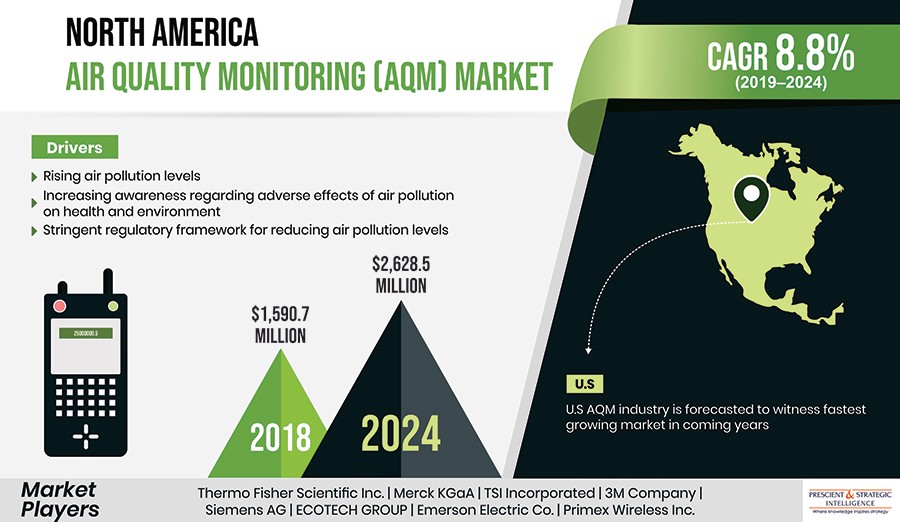Industrial Source Program, Mobile Source Program, and Indoor Air Program of the EPA aim to reduce air pollution in the U.S. The Clean Air Act under Industrial Source Program requires the EPA to regulate hazardous air pollutants from large manufacturing plants in two phases. Likewise, the Clean Diesel Program under the Mobile Source Program aims to reduce vehicular emissions in the U.S. Thus, the implementation of stringent government policies on air pollution mitigation will encourage the use of air quality monitoring (AQM) products in North America.
Moreover, the rising urban population will help the North American air quality monitoring market demonstrate a CAGR of 8.8% between 2019 and 2024. According to P&S Intelligence, the market will generate $2,628.5 million revenue by 2024. As per the 2018 Revision of World Urbanization Prospects by the Population Division of the UNDESA, nearly 82% of the North American population was living in urban areas in 2018. Furthermore, the World Bank estimates that the urban population of the U.S. grew from 270,737,596 in 2019 to 272,364,755 in 2020.
Additionally, the mounting public awareness about the harmful effects of air pollution will propel the deployment of air quality monitoring products in the region. For instance, long- and short-term exposure to PM2.5 can cause premature death and harm the cardiovascular system. In addition, long-term exposure to ozone can increase the frequency of asthma attacks, aggravate lung disease, result in shortness of breath, and cause permanent damage to the lungs. Moreover, exposure to both these pollutants can impair visibility and cause environmental damage.
With rising air pollution concerns, the people of the North American region are adopting indoor AQM products such as fixed and portable, and outdoor AQM products such as dust and particulate, fixed, portable, and AQM stations. Currently, the pharmaceutical industry, petrochemical industry, commercial and residential sectors, power generation plants, government agencies, and academic institutes of North America are preferring indoor products over outdoor ones, as a large number of pollutants are generated indoors. Indoor facilities produce bacteria and viruses, asbestos, lead, formaldehyde, CO, and secondhand smoke in abundance.
Indoor and outdoor AQM products used in North America are offered by Primex Wireless Inc., Emerson Electric Co., TSI Incorporated, ECOTECH GROUP, Merck KGaA, and Teledyne Technologies Incorporated. AQM devices of these companies monitor air through manual, continuous, intermittent, or passive sampling methods. These products are used to monitor the content of lead, SO2, NO2, PM2.5, CO, ozone gas, arsenic element, PM10, and NH3 in the air. Additionally, AQM products also monitor coarse particulates, such as earth crust materials and road vehicle dust, and fine particles, such as secondarily formed aerosols and combustion particles.
In the last few years, the U.S. has emerged as a leader in the North American air quality monitoring market, due to the soaring pollution and smoke levels in the country. An exponential surge in pollution levels has increased the burden of respiratory disorders in the nation. According to the EPA, exposure to particle pollution causes cough, wheeze, phlegm, acute phase reaction, inflammation of the lungs and airways, asthma, premature mortality in people living with chronic lung disease, and bronchial hyperreactivity among the people of the U.S.
Thus, the large-scale implementation of numerous regulations on air pollution mitigation and massive public awareness about the detrimental impact of air pollution will fuel the adoption of AQM products in North America.


